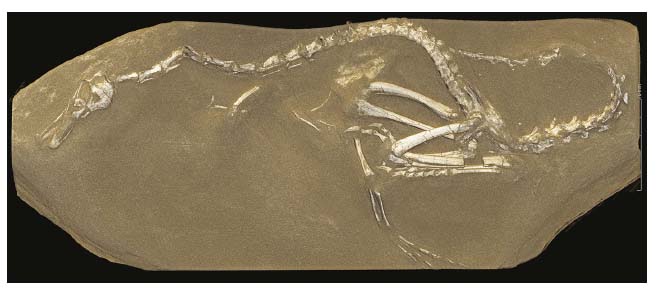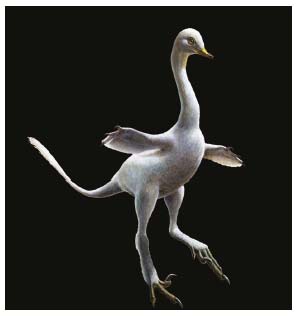- Home
- Users & Science
- Scientific Documentation
- ESRF Highlights
- ESRF Highlights 2017
- Structure of materials
- Amphibious bird-like raptor introduces new group of predatory dinosaurs
Amphibious bird-like raptor introduces new group of predatory dinosaurs
Mesozoic dinosaurs were not all stamping giants but also included the Maniraptora: a diverse group of small and agile meat-eating dinosaurs that includes all birds. The discovery of a bizarre new Cretaceous maniraptoran demonstrates that these hunters also exploited an amphibious niche.
A small, exquisitely preserved dinosaur skeleton (Figure 113) was poached from the famous Djadokhta Formation in southern Mongolia and resided in private collections before it was offered for palaeontological study. The fossil was partially prepared out of the Cretaceous sediment and revealed a stunning amount of detail, through which it identified itself as a member of the Maniraptora; the group of dinosaurs that includes the iconic raptors but also encompasses all birds. Nevertheless, particular properties of its morphology, preservation, and conservation also raised substantial doubts concerning the integrity of the specimen. The fact that the fossil united characteristics previously known from a diverse variety of taxa in a single individual fueled the suspicion that it may represent a chimera. This motivated a comprehensive tomographical study of the specimen to assess its integrity and to obtain more information on the skeletal elements that remained hidden inside the rock.
Hierarchical phase-contrast imaging was carried out at beamlines BM05 and ID19. It was found that secondarily precipitated metallic oxides induced strong artefacts in the reconstructed volumes, which were corrected through newly designed texture enhancement and normalisation protocols. The improved data set demonstrated that the rock matrix was continuous, with original cracks propagating through the sediment and bones in unity. Furthermore, taking a certain degree of taphonomical influence into account, the important anatomical relation between the skull and neck vertebrae appears to have been conservatively retained. The left anterior limb visible on the outside of the rock was found to have been retouched during restoration but the morphology of its arm bones mirrors that of the right anterior limb still present inside the rock, which confirmed that the left arm belongs to the same individual. This observation is corroborated by the presence of a single growth line present in long bones of all four limbs, as well as in the mandible. Finally, the functional morphology of the skeleton proved internally consistent as well: adaptations in the pelvic girdle allow for a more erect posture that counteracts imbalance potentially imposed by the elongated neck.
 |
|
Fig. 113: 3D rendering of Halszkaraptor escuilliei holotype (MPC D-102/109) from synchrotron tomographic data. |
Analyses revealed that the platyrostral snout accommodated an unexpectedly large number of tubular teeth in an intricate replacement system as well as a nervous network similar to those of crocodilians and other reptilian aquatic hunters employing a well-developed sense of mechanoreception [1]. The skull connects to an elongated yet flexible neck that makes up circa 50% of the snout-sacrum length. The ulna exhibits a certain degree of dorsoventral flattening, which is also present in modern birds that employ wing-propelled diving. The geometry of the hand is remarkable in that the lateralmost third finger is longer than the second (middle) finger, which resembles the condition in flippers of long-necked aquatic reptiles. The posterior limbs sport the hypertrophied “killing claws” shared with other raptorial dinosaurs and appear well-suited for terrestrial locomotion. This unique combination of characteristics (Figure 114) advocates an amphibious lifestyle: terrestrial bipedal locomotion combined with adaptations that enable aquatic piscivorous foraging and anguilliform swimming assisted by the anterior limbs. Its long neck would have enabled successful hunting in a fashion not unlike the present-day feeding tactics employed by herons.
 |
|
Fig. 114: Life reconstruction of Halszkaraptor escuilliei (artwork by Lukas Panzarin / Andrea Cau). |
The new species was named Halszkaraptor escuilliei in recognition of both the late Polish palaeontologist Halszka Osmólska, and François Escuillié who returned the poached fossil to Mongolia. This enigmatic dinosaur not only accounts for the first representative of this new species and genus, but also explains the interrelationships between two other Mongolian raptors that have proved challenging to place before: Halszkaraptor allies with Hulsanpes and Mahakala in the new subfamily Halszkaraptorinae. Although future research will illuminate the potential presence of homologous amphibious adaptations in the thus-far poorly sampled genera Hulsanpes and Mahakala, Halszkaraptor now clearly demonstrates that maniraptoran dinosaurs not only engaged in agile terrestrial foraging and developed the capability of flight, but also exploited amphibious niches. This, in turn, not only expanded the ecological range of non-avian theropod dinosaurs [2], but may also explain some of the evolutionary flexibility of Maniraptora that enabled birds to survive the end-Cretaceous mass extinction and occupy their status as the most successful class of vertebrates today.
Principal publication and authors
Synchrotron scanning reveals amphibious ecomorphology in a new clade of bird-like dinosaurs, A. Cau (a), V. Beyrand (b, c), D. Voeten (b, c), V. Fernandez (b), P. Tafforeau (b), K. Stein (d), R. Barsbold (e), K. Tsogtbaatar (f), P.J. Currie (g) and P. Godefroit (h), Nature 552, 395-399 (2017); doi: 10.1038/nature24679.
(a) Geological and Palaeontological Museum ‘Giovanni Capellini’, Bologna (Italy)
(b) ESRF
(c) Department of Zoology and Laboratory of Ornithology, Palacký University, Olomouc (Czech Republic)
(d) Earth System Science – AMGC Vrije Universiteit Brussel, Brussels (Belgium)
(e) Palaeontological Center, Mongolian Academy of Sciences, Ulaanbaatar (Mongolia)
(f) Institute of Palaeontology and Geology, Mongolian Academy of Sciences, Ulaanbaatar (Mongolia)
(g) Department of Biological Sciences, University of Alberta, Edmonton, Alberta (Canada)
(h) Directorate Earth & History of Life, Royal Belgian Institute of Natural Sciences, Brussels (Belgium)
References
[1] C.T. Barker et al., Sci. Rep. 7, 3749 (2017).
[2] L.E. Zanno and P.J. Makovicky, PNAS 108, 232-237 (2011).



